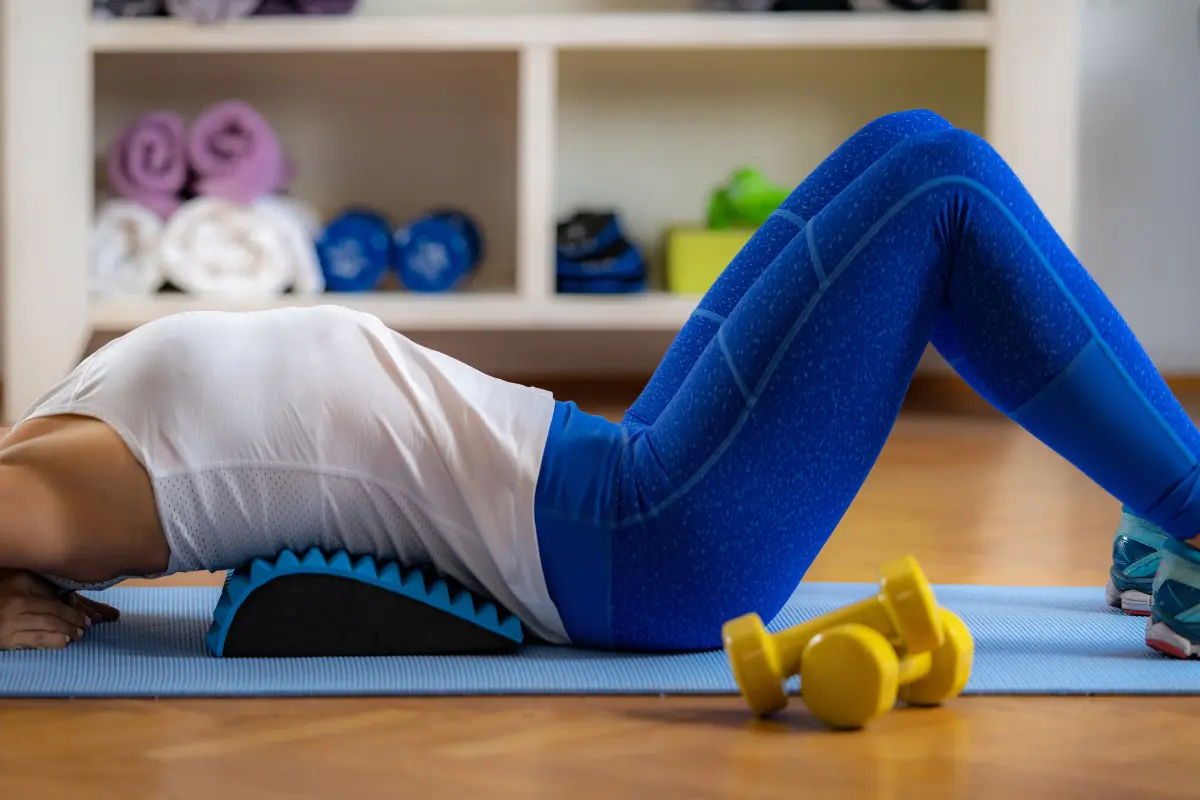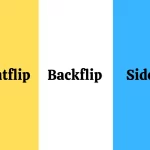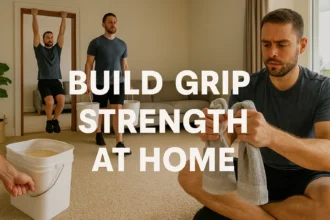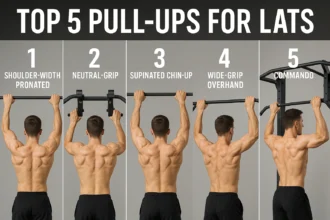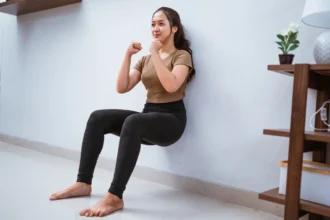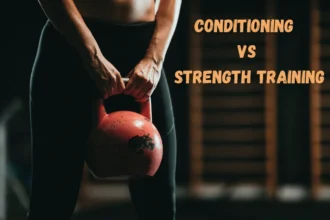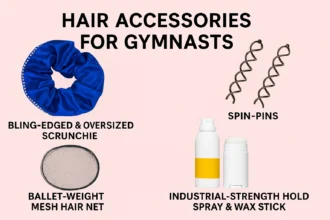Today, we’ll go through a simple yet powerful daily stretch routine from Anna McNulty to help you get a flexible back fast. This 8-minute routine is designed to target back flexibility from various angles, offering a mix of stretches suitable for both beginners and advanced practitioners.
1. Reach and Flat Back Stretch
Start Position: Stand tall with your feet hip-width apart. Reach both arms overhead, keeping your shoulders relaxed.
Action: Slowly hinge at your hips and begin to fold forward, keeping your back as flat as possible. Your goal is to create a straight line from your tailbone to the crown of your head, avoiding any arching or rounding in your spine. As you fold, pull your arms forward and push your hips back. This motion helps lengthen your torso and deeply stretches your hamstrings and lower back.
Focus Points:
- Keep your knees slightly bent if necessary to protect your lower back.
- Try to keep your back as flat as possible, rather than curving forward. If you can’t reach the floor with your hands, that’s okay—just focus on creating length in your spine.
- Reach your hands toward the floor, aiming for your feet. The deeper you can go without rounding your back, the more effective the stretch.
Modification: If you’re unable to touch the floor, stop where you feel a good stretch, and don’t force it.
2. Deepen the Stretch: Reach for Your Feet
Action: Once you feel the initial stretch, reach your hands as close to your feet as you can. If you’re able to get your hands to the floor comfortably, bend your arms to deepen the stretch. Try pulling your chest closer to your thighs to intensify the hamstring stretch.
Focus Points:
- Keep your back flat—avoid rounding at any cost. This will help you achieve a safer, deeper stretch.
- If you can already touch the ground, bending your arms can allow you to get deeper into your hamstrings and lower back.
Modification: If reaching your feet is difficult, it’s better to focus on lengthening your back and bringing your chest closer to your thighs rather than forcing the reach.
3. Standing Backbend
Start Position: Slowly roll back up to a standing position. Once you’re upright, slowly begin to arch backward into a gentle backbend. Start by bending from your upper back and trying to open your chest towards the ceiling.
Action: Reach your arms up and over, bringing your head back. You should feel a gentle stretch through the spine. If you’re new to backbends, don’t force yourself to go too deep—just aim to arch as much as you can while keeping your legs straight and strong.
Focus Points:
- Keep your core engaged to prevent overextension of the lower back.
- Don’t let your knees buckle or collapse inward; keep them slightly soft but engaged to support your body.
Modification: If a backbend is challenging, simply arch back as far as your body comfortably allows. Aiming to stretch your chest and abdomen forward while keeping your hips stacked over your feet is key.
Advanced Option: If you’re more experienced with backbends, bring your hands and feet closer together, which will allow you to go deeper into the stretch.
4. Leg-Lifting Backbend
Start Position: Return to your backbend position, but this time lift one leg off the ground. Hold it up for a few seconds, focusing on your balance and deepening the backbend.
Action: Slowly bring the lifted leg back down and rest for a few seconds. Then, lift the opposite leg off the ground. This variation helps challenge your balance and works your core more while still targeting your back.
Focus Points:
- Keep your hips square and even, preventing any tilting as you lift your leg.
- Engage your core to help maintain balance while lifting your leg.
Modification: If you find this too difficult, simply continue to hold the backbend without lifting your leg, focusing on the flexibility aspect.
5. Elbow Backbend
Action: From your backbend, lower your body down onto your elbows for a deeper stretch. Your elbows should be bent, and your chest should be moving towards the floor. This variation will intensify the backbend, stretching the spine even further and helping you work on your upper back and shoulders.
Focus Points:
- As you go into the elbow backbend, keep your hips lifted to prevent any strain in your lower back.
- This is an intense stretch, so only go as far as feels comfortable.
Modification: If you’re still working on backbends, hold the modified version of the standing backbend or even skip this step if you’re not ready.
Advanced Option: If you’re confident in your backbend, try pushing up into a full backbend, which engages even more of the spinal muscles.
6. Downward Dog to Stretch Your Back
Start Position: Transition into a Downward Dog position by starting on your hands and knees, then lifting your hips toward the ceiling. Your body should form an inverted V shape. This classic yoga pose stretches both your back and your hamstrings.
Action: Hold this position for a few breaths, letting your back stretch out naturally. As you hold, push your heels towards the floor and let your chest sink towards the floor. This will deepen the stretch and help lengthen your spine.
Focus Points:
- Keep your hands shoulder-width apart and your feet hip-width apart.
- Don’t let your shoulders bunch up by your ears; instead, reach your chest toward your thighs.
Modification: If you’re new to this pose, you can keep your knees slightly bent and focus on lengthening your back.
7. Child’s Pose with a Twist
Start Position: Lower your hips to your heels and come into a Child’s Pose position. This resting pose is excellent for calming the body after more intense stretches.
Action: In this variation, try to lift your hips up slightly while still reaching your arms forward. This will create a stretch in your back and shoulders. You can also try reaching back to grab your ankles for a deeper stretch.
Focus Points:
- Relax your neck and shoulders as you stretch forward.
- Focus on the stretch in your back, avoiding any strain in the knees or hips.
8. Reaching for Your Ankles
Action: From your stomach, try reaching back to grab your ankles. This stretch targets your quads and back, providing a deep stretch along your spine.
Focus Points:
- If you can’t reach your ankles, don’t worry! Simply reach as far as you can and stay within your flexibility limits.
- Try to keep your shoulders and chest lifted slightly off the floor as you stretch, deepening the stretch in your lower back and hips.
Modification: If you can’t grab your ankles yet, try using a towel or yoga belt around your ankles to assist with the stretch.
9. Knee Backbend
Start Position: Sit on your knees with your feet pointed behind you. Begin by arching your back slowly, lifting your chest toward the ceiling. If you’re a beginner, only aim for a gentle backbend without reaching for your feet.
Action: For more advanced practitioners, you can extend your arms overhead, stretching deeper into the backbend. If you’re very advanced, attempt a Triple Fold by pushing your head through the space between your knees.
Focus Points:
- Keep your core engaged to support your lower back.
- Only attempt deeper variations if you have the necessary flexibility and strength.
10. Final Rest: Child’s Pose
End your routine by returning to Child’s Pose, which will help release any tension built up during the backbend stretches. Take deep, relaxing breaths, allowing your body to relax and reset.
By incorporating this 8-minute routine into your daily practice, you’ll gradually improve your back flexibility and strength. With dedication, you’ll notice increased mobility and reduced tension in your back, leading to better posture and overall flexibility.


